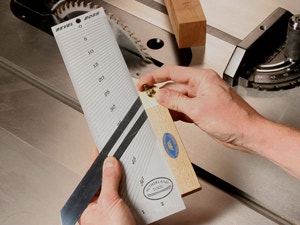How Can I Set Accurate Bevel Tilt Angles?
I am working on a project that requires eight 1x2 slats cut at 10 deg. on both edges. When you put them all together, they make a round door. My question is, how do I cut exactly 10 degrees? For that matter, how do you cut any angle other than 90 or 45 degrees? These two angles can be checked with a triangle, but there must be a quick and accurate way to set a saw blade to do all the angles in between. - Richard Caya
Chris Marshall: I use two different approaches for setting accurate bevel tilts, but both of my suggestions will probably require you a smallish tool purchase or two. The first is to use an adjustable bevel gauge (the classic type with a blade you can swivel and lock to any angle setting).
My second suggestion is to use a digital angle finder that clamps magnetically to your saw blade. Set the blade to 0 degrees, calibrate the angle finder to 0 degrees by pushing a button, then crank the blade over until the angle finder reads the angle you want. It's also perfectly simple to use. Wixey invented it, and now there are numerous knockoffs of the same device. I go with these two approaches because an ordinary "school" type protractor is too small to give me the degree of accuracy I want when setting blade angles with a bevel gauge.
Tim Inman: I'm not sure from your question whether you're wanting to build a barrel or a pie with your slats. (In other words, are the angles to be cut on the edges or the faces of the boards?) Either way, the angled cuts are set up using similar techniques. To set the appropriate device (saw blade, bevel jig or rip fence, etc.) at the 10 degree angle, you need a basic protractor and a bevel gauge. Use the protractor to set the bevel gauge to the 10 degree angle you have specified. Double check your angles. I'd recommend laying this out with scrap cardboard or something quick and easy to make sure you're right. Once the bevel gauge is set, and the angles confirmed, use the gauge to transfer the angle settings to your saw.
So much for geometry. Now for some practical shop technique: Setting the EXACT right angle, and then cutting the EXACT right angle is virtually impossible. So here's what I do. Set up the tooling as close as you can; be precise. Then, divide and conquer. Do partial glue-ups of sections. I'd suggest quarters or halves of your shape. Mate the angled edges or faces tightly and glue them up. Let the glue set for the required time, depending upon your glue product. After the sections are dried and hard, refit these sections together to make them join perfectly with their mates - the other glued-up sections. In other words, recut the half-sections or the quarter-sections to make them fit EXACTLY - even though the angle might be slightly compromised. It is much better to have the joints closely fitted and tight than to worry about precise geometry and angles. This is much easier to show than tell, but hopefully, my words will give you the idea. Read about segmented turning glue-up techniques if I'm not being clear enough or if you want to see how others have done this. The segmented turners have used this trick for years, and your problem parallels theirs.
Keep the inspiration coming!
Subscribe to our newsletter for more woodworking tips and tricks







